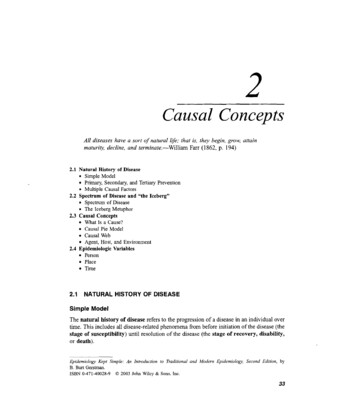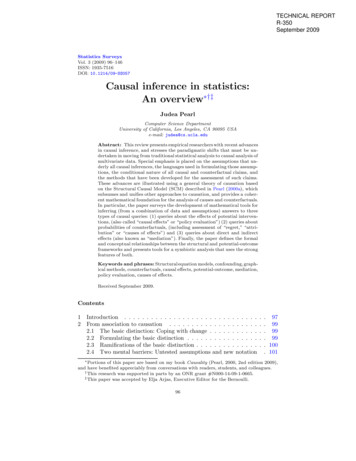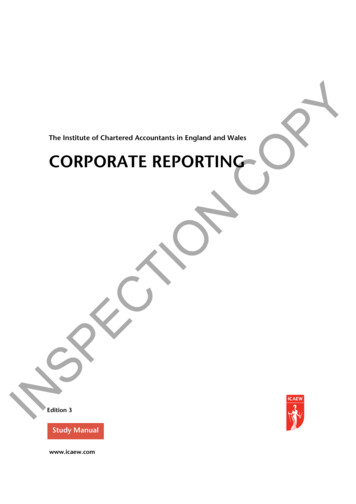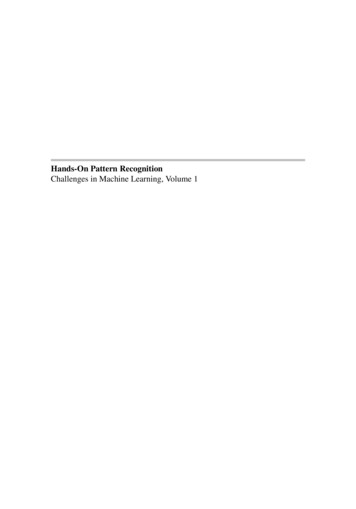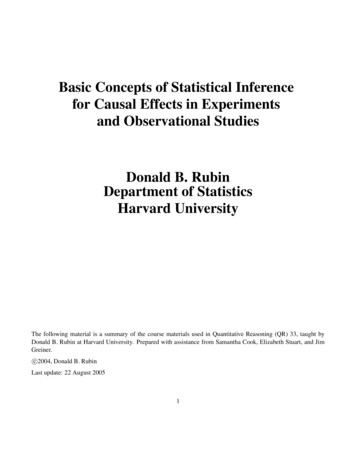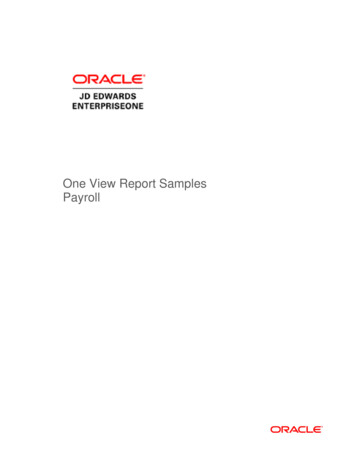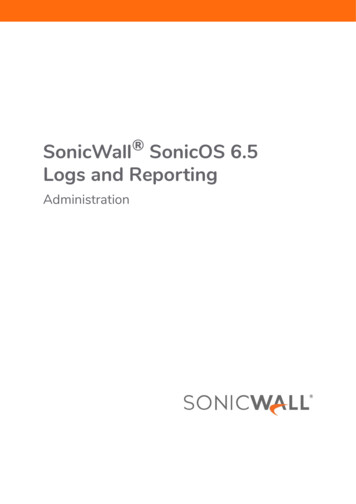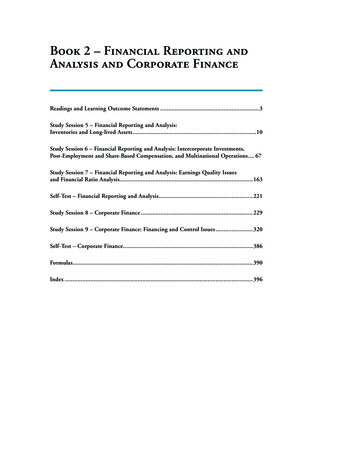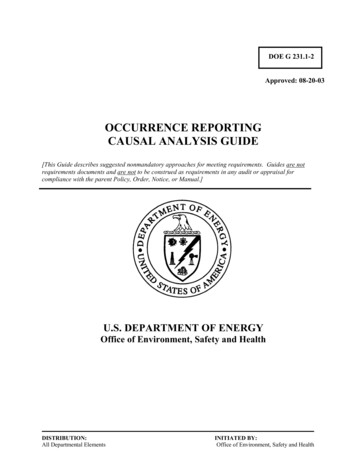
Transcription
DOE G 231.1-2Approved: 08-20-03OCCURRENCE REPORTINGCAUSAL ANALYSIS GUIDE[This Guide describes suggested nonmandatory approaches for meeting requirements. Guides are notrequirements documents and are not to be construed as requirements in any audit or appraisal forcompliance with the parent Policy, Order, Notice, or Manual.]U.S. DEPARTMENT OF ENERGYOffice of Environment, Safety and HealthDISTRIBUTION:All Departmental ElementsINITIATED BY:Office of Environment, Safety and Health
DOE G 231.1-208-20-03Page iCONTENTS1.PURPOSE .12.REFERENCES .13.INTRODUCTION .14.CAUSAL ANALYSIS TREE DESCRIPTION.25.CAUSAL ANALYSIS PROCESS GUIDANCE.2A. Operational Emergency (SC OE) .2B. Significance Category 1 (SC 1) . .2C. Significance Category R (SC R) .2D. Significance Category 2 (SC 2) and Significance Category 3 (SC 3) .2E. Significance Category 4 (SC 4) .3F. Evaluation of Significance Categories .3G. Guidance Tables .36.CAUSAL ANALYSIS PROCESS .5
Page iiDOE G 231.1-208-20-03ATTACHMENTSATTACHMENT 1.ISM FUNCTIONS AND THE B-LEVEL CAUSAL ANALYSIS TREEBRANCHESATTACHMENT 2.CAUSAL ANALYSIS TREEATTACHMENT 3.CAUSAL ANALYSIS KEY TERMS AND DEFINITIONSATTACHMENT 4.CAUSAL FACTOR IDENTIFICATION METHODOLOGIESATTACHMENT 5.INPO ERROR PRECURSORS (SHORT LIST) VERSUS CAUSALANALYSIS TREE C NODESATTACHMENT 6.CAT BRANCH A3 MATRIXATTACHMENT 7.CAUSAL ANALYSIS NODE DESCRIPTIONSATTACHMENT 8.REFERENCES
DOE G 231.1-208-20-031.Page 1PURPOSEThis Guide is intended to assist personnel in determining the Apparent Cause(s) of specific reportableoccurrences and to explain the structure and nodes of the Causal Analysis Tree for use in occurrence reportingand causal analysis. It does not introduce or impose any new requirements and is to be used in conjunction withthe References listed below.2.REFERENCESDOE O 231.1A, Environment, Safety and Health Reporting, dated 08-19-03DOE M 231.1-2, Occurrence Reporting and Processing of Operations Information, dated 08-19-03DOE G 231.1-1, Occurrence Reporting and Performance Analysis Guide, dated 08-20-033.INTRODUCTIONThe Department of Energy has established the requirements for identification of occurrences/events,categorization of the significance of the identified events, determination of the cause or causes of the events,and development of corrective actions designed to eliminate the events and to prevent their recurrence using agraded approach based on the significance of the event. Figure 1 illustrates the relationship between theSignificance Category (SC) and the causal analysis step from the Occurrence Reporting Model in Section 11 ofDOE M 231.1-2, Occurrence Reporting and Processing of Operations Information.EventIdentification /DocumentationFIGURE 1SCIdentifiedOERoot CauseDetermined1Root CauseDeterminedRRecurring EventRoot CauseDetermined2Apparent CauseDetermined3Apparent CauseDetermined4Causal Analysisper ContractorCorrective ActionProgram
Page 2DOE G 231.1-208-20-03Typically, more investigation and analysis is necessary as the level of significance of the identified eventincreases (i.e., the SC number decreases). The scope of the corrective actions being developed also becomesmore extensive as the significance level of the event increases. This Guide does not address specific RootCause methodologies that can be used to determine the Root Cause(s) of an event. Rather, it addresses theApparent Cause analysis and use of the Causal Analysis Tree (CAT) to determine the causes for all events.4.CAUSAL ANALYSIS TREE DESCRIPTIONThe Causal Analysis Tree (CAT) has been developed to assist in the assignment of Apparent Cause(s) toidentified events and for use in coding causes for all occurrences. The CAT is shown in Attachment 1 (“B”Level) and Attachment 2 (“C”-Level) of the Guide. The CAT is a result of a benchmarking study of industrycausal analysis systems. The lowest level of the CAT is typically referred to as the “C” Level of the CAT.Attachment 7 provides a detailed description of each “C”-Level node in the CAT with examples and potentialcorrective actions identified.In accordance with DOE M 231.1-2, guidance found in Table I of this Guide, used in conjunction with theCAT, allows for a tailored approach to developing corrective actions based on the significance category. TableI also prompts for the identification of applicable ISM Core Functions. For instance, as shown in Table I, for aSC 1 event or a recurring event (R) identified during performance analysis, root causes should be determined,and corrective actions should be identified to remedy the problem, prevent recurrence of the specific problem,and also preclude occurrence of similar problems. However, for a SC 3 event, Apparent Cause(s) are identifiedand the corrective actions are targeted to remedy the problem.5.CAUSAL ANALYSIS PROCESS GUIDANCETable I, Causal Analysis Process Guidance, and the CAT should be used to implement the causal analysisprocess such that appropriate corrective actions can be determined according to the significance of the event.The causal analysis guidance discussed below meets the minimum requirements; however, there may beadditional causal analysis requirements imposed by individual organizations.A.Operational Emergency (SC OE)A team using any formal causal analysis method (e.g., interviews, event and causal factors charting,barrier analysis, or change analysis) should perform an analysis of SC OE events to determine RootCause(s). Any site-specific Root Cause methodology can be used to determine Root Cause(s). Inaddition, all of the cause codes for entry in the occurrence reports should be selected from the CAT.At least one investigation team member should be a trained investigator per DOE M 231.1-2,Occurrence Reporting and Processing of Operations Information, should understand the CAT, andshould have experience in previous investigations. Corrective actions for SC OE events are to bedeveloped to remedy the problem, prevent its recurrence, and also preclude the occurrence of similarproblems.B.Significance Category 1 (SC 1)A team with a trained investigator, as defined in DOE M 231.1-2, should use the methods described in(A) above to analyze SC 1 events. Additionally, corrective action methods as described in (A) alsoapply to SC 1 events.C.Significance Category R (SC R)A trained investigator, as defined in DOE M 231.1-2, should use the methods described in (A) above toanalyze SC R events. Additionally, corrective action methods as described in (A) also apply to SC Revents.D.Significance Category 2 (SC 2) and Significance Category 3 (SC 3)
DOE G 231.1-208-20-03Page 3For SC 2 and SC 3 events, a trained investigator should use the best available information (such ascritiques, log entries, or engineering judgment) to determine Apparent Causes using the CAT.Corrective actions for SC 2 events are required to remedy the problem and prevent its recurrence.Corrective actions for SC 3 events are required only to remedy the problem.E.Significance Category 4 (SC 4)Analysis of SC 4 events is accomplished per the contractor’s specific corrective action program.F.Evaluation of Significance CategoriesUpon completion of the analysis of the event, the significance category should be reviewed forappropriateness based on any new information that may have been identified during the investigation.If it is determined that the significance category of the event should be higher or lower (i.e., thereporting criterion has changed), then the correct reporting criterion should be assigned, which willresult in an automatic change to the significance category. The causal analysis should then bereworked to the requirements of the higher or lower significance category. In such cases, the reportingorganization needs to submit an Update Report or, if the occurrence does not meet any of the reportingcriteria, the existing report can be cancelled.G.Guidance TablesThe guidance listed in Sections A – E is summarized in Table I.
Page 4DOE G 231.1-208-20-03TABLE ICAUSAL ANALYSIS PROCESS GUIDANCESignificanceCategoryOE1Causal Analysis LevelAll causes of the eventare determined anddocumented using theorganization’s approvedRoot Cause AnalysisProcess.All causes of the eventare determined anddocumented using theorganization’s approvedRoot Cause AnalysisProcess.RSame as SC 1 above2Apparent Cause(s) of theevent is identified anddocumented.34Apparent Cause(s) of theevent is identified anddocumented.Analysis Requirements Identify deficient ISMcore functions Perform Root CauseAnalysis Select all appropriateCause Codes (LevelsA, B, and C of theCAT) Identify deficient ISMcore functions Perform Root CauseAnalysis Select all appropriateCause Codes (LevelsA, B, and C of theCAT)Same as SC 1 above Identify deficient ISM corefunctions Apparent Cause Analysis(Levels A, B, and C of theCAT) Identify deficient ISM corefunctions Apparent Cause Analysis(Levels A, B, and C of theCAT)Corrective Action DevelopmentRequirementsCorrective Actions are designed to remedythe problem, prevent recurrence of thespecific problem, and preclude occurrenceof similar problems.Corrective Actions are designed to remedythe problem, prevent recurrence of thespecific problem, and preclude occurrenceof similar problems.Same as SC 1 aboveCorrective Actions are designed to remedythe problem and prevent its recurrence.Corrective Actions are designed to remedythe problem.Analysis and Actions per the contractor specific Corrective Action Program.
DOE G 231.1-208-20-036.Page 5CAUSAL ANALYSIS PROCESSThe causal analysis process is an integral part of the Occurrence Reporting and Processing System (ORPS)model and supports the required Performance Analysis process described in the Occurrence Reporting andPerformance Analysis Guide, DOE G 231.1-1. When implementing the causal analysis process, ApparentCause(s) are identified as the most probable cause(s) of an event or condition that management has the controlto fix and for which effective recommendations for corrective actions can be generated. A model for the causalanalysis process is provided below. Causal Analysis Key Terms and Definitions are provided in Attachment 3.There are three basic steps in the process: 1) identifying causal factors, 2) selecting ISM Core Functions, 3)using the CAT to identify Apparent Causes/Cause Codes.1.Identify Causal Factors. Use one of the contractor’s supported/recommended methodologies or thosemethodologies recommended in Attachment 4 to determine causal factors.2.Select Applicable ISM Core Function(s). Select all of the ISM core function(s) necessary to identify anyobserved weakness(es) in the facility's implementation of the ISM program (Attachment 1). Deficient ISMCore Functions are considered to be Causal Factors and processed in the same manner as the CausalFactors determined above.3.Use the CAT to Identify Apparent Causes/Cause Codes. Use the CAT (Attachment 2) to determine theappropriate cause(s) for each causal factor identified. Causal Analysis Node Descriptions are shown inAttachment 7 and can be used, as needed, to determine the appropriate cause(s). Additionally, the logicprovided below for using the CAT will ensure that all possible cause(s) are considered during the analysis.A. Use the Design/Engineering (A1) Branch and the Equipment/Material (A2) Branch to codify anydesign/equipment related deficiencies.B. Use the Human Performance (A3) Branch to codify errors by personnel. If any Human PerformanceCodes are determined to be applicable, use Attachment 6 to determine applicable C level apparentcause codes in the other branches that may have caused the resultant human error. These codescoupled together describe the cause of the human error.C. Use the Management Problem (A4), Communications LTA (A5), Training Deficiency (A6), and OtherProblem (A7) branches to determine other Cause Codes.D. Repeat this process with remaining causal factors until all causal factors have been addressed.
DOE G 231.1-208-20-03Attachment 1Page 1Attachment 1INTEGRATED SAFETY MANAGEMENT FUNCTIONS ANDTHE B-LEVEL CAUSAL ANALYSIS TREE BRANCHESThe objective of ISM is to integrate safety considerations into management and work practices at all levels to accomplishmissions while protecting the public, the worker, and the environment. Identification of a breakdown or gap in an ISMcore function is considered essential; the information provides additional insight into the probable cause of theoccurrence. Deficient ISM Core Functions are considered to be Causal Factors and processed in the same manner as theCausal Factors determined above.Integrated Safety ManagementScope of WorkLTADetermination ofDeficient ISMFunctionAnalyzedHazards LTADeveloped /ImplementedControls LTACausal Analysis TreeA1Design/EngineeringProblemB1 DESIGN INPUTLTAB2 DESIGNOUTPUT LTAB3 DESIGN/DOCUMENTATIONLTAB4 DESIGN/INSTALLATIONVERIFICATION LTAB5 OPERABILITYOF DESIGN/ENVIRONMENTLTAPerformed workwithin uman PerformanceLTAB1 CALIBRATION FORINSTRUMENTS LTAB1 SKILL BASEDERRORB2 PERIODIC/CORRECTIVEMAINTENANCE LTAB2 RULE BASEDERRORB3 INSPECTION/TESTING LTAB3 KNOWLEDGEBASED ERRORB4 WORKPRACTICES LTAB4 MATERIALCONTROL LTAB5 PROCUREMENTCONTROL LTAA4Management ProblemB1 MANAGEMENTMETHODS LTAB2 RESOURCEMANAGEMENTLTAB3 WORKORGANIZATION &PLANNING LTAB4 SUPERVISORYMETHODS LTAB5 CHANGEMANAGEMENT LTAB6 DEFECTIVE,FAILED ORCONTAMINATEDLevel A nodes are underlined.Level B nodes are in ALL CAPS.Feedback encyB1 WRITTENCOMMUNICATIONSMETHOD OFPRESENTATIONB1 NOTRAININGPROVIDEDB2 WRITTENCOMMUNICATIONCONTENT LTAB3 WRITTENCOMMUNICATIONNOT USEDB2 TRAININGMETHODS LTAB3 TRAININGMATERIALLTAB4 VERBALCOMMUNICATION LTAA7 Other ProblemLevel C nodes are in “Sentence case.”LTA Less than AdequateB1 EXTERNALPHENOMENAB2 RADIOLOGICAL/HAZARDOUSMATERIAL PROBLEM
DOE G 231.1-208-20-03Attachment 2Page 1Attachment 2Causal Analysis Tree Rev. 0A1 Design / EngineeringProblemB1 DESIGN INPUT LTAC01 Design input cannotbe metC02 Design input obsoleteC03 Design input notcorrectC04 Necessary designinput not availableB2 DESIGN OUTPUT LTAC01 Design output scopeLTAC02 Design output notclearC03 Design output notcorrectC04 Inconsistent designoutputC05 Design input notaddressed in design outputC06 Drawing,specification, or data errorC07 Error in equipment ormaterial selectionC08 Errors not detectableC09 Errors not recoverableB3 DESIGN /DOCUMENTATION LTAC01 Design / documentationnot completeC02 Design / documentationnot up-to-dateC03 Design / documentationnot controlledB4 DESIGN /INSTALLATIONVERIFICATION LTAC01 Independent review ofdesign / documentationLTAC02 Testing of design /installation LTAC03 Independentinspection of design /installation LTAC04 Acceptance ofdesign / installation LTAB5 OPERABILITYOF DESIGN /ENVIRONMENT LTAC01 Ergonomics LTAC02 Physical environmentLTAC03 Natural environmentLTAA2 Equipment / MaterialProblemB1 CALIBRATION FORINSTRUMENTS LTAC01 Calibration LTAC02 Equipment foundoutside acceptance criteriaB2 PERIODIC /CORRECTIVEMAINTENANCE LTAC01 Preventivemaintenance for equipmentLTAC02 Predictive maintenanceLTAC03 Correctivemaintenance LTAC04 Equipment historyLTAB3 INSPECTION / TESTINGLTAC01 Start-up testing LTAC02 Inspection / testing LTAC03 Post-maintenance / Postmodification testing LTAB4 MATERIAL CONTROLLTAC01 Material handling LTAC02 Material storage LTAC03 Material packagingLTAC04 Material shipping LTAC05 Shelf life exceededC06 Unauthorized materialsubstitutionC07 Marking / labeling LTAB5 PROCUREMENTCONTROL LTAC01 Control of changes toprocurement specifications /purchase order LTAC02 Fabricated item didnot meet requirementsC03 Incorrect item receivedC04 Product acceptancerequirements LTAB6 DEFECTIVE, FAILEDOR CONTAMINATEDC01 Defective or failed partC02 Defective or failedmaterialC03 Defective weld, brazeor soldering jointC04 End of life failureC05 Electrical or instrumentnoiseC06 ContaminantA3 Human PerformanceLTAB1 SKILL BASED ERRORC01 Check of work was LTAC02 Step was omitted due todistractionC03 Incorrect performance due tomental lapseC04 Infrequently performed stepswere performed incorrectlyC05 Delay in time cause d LTAactionsC06 Wrong action selected basedon similarity with other actionsC07 Omission / repeating of stepsdue to assumptions forcompletionB2 RULE BASED ERRORC01 Strong rule incorrectlychosen over other rulesC02 Signs to stop were ignoredand step performed incorrectlyC03 Too much activity wasoccurring and error made inproblem solvingC04 Previous success in use ofrule reinforce d continued use ofruleC05 Situation incorrectlyidentified or represented result ingin wrong rule usedB3 KNOWLEDGE BASEDERRORC01 Attention was given to wrongissuesC02 LTA Conclusion based onsequencing of factsC03 Individual justifie d action byfocusing on biased evidenceC04 LTA review based onassumption that process will notchangeC05 Incorrect assumption that acorrelation existed between two ormore factsC06 Individual underestimated theproblem by using past events asbasisB4 WORK PRACTICES LTAC01 Individual ’s capability toperform work LTA [Examplesinclude: Sensory / perceptualcapabilities LTA, Motor / physicalcapabilities LTA, and Attitude /psychological profile LTA.]C02 Deliberate violationSTARTHEREA4 Management ProblemB1 MANAGEMENT METHODSLTAC01 Management policy guidance/expectations not well-defined,understood or enforcedC02 Job performance standards notadequately definedC03 Management direction createdinsufficient awareness of impact ofactions on safety / reliabilityC04 Management follow-up ormonitoring of activities did notidentify problemsC05 Management assessment did notdetermine cause s of previous event orknown problemC06 Previous industry or in-houseexperience was not effectively usedto prevent recurrenceC07 Responsibility of personnel notwell-defined or personnel not heldaccountableC08 Corrective action responses to aknown or repetitive problem wasuntimelyC09 Corrective action for previouslyidentified problem or event was notadequate to prevent recurrenceB2 RESOURCE MANAGEMENTLTAC01 Too many administrative dutiesassigned to immediate supervisorC02 Insufficient supervisory resourcesto provide necessary supervisionC03 Insufficient manpower to supportidentified goal / objectiveC04 Resources not provided to assureadequate training was provided /maintainedC05 Needed resource changes notapproved / fundedC06 Means not provided to assureprocedures / documents / records wereof adequate quality and up -to-dateC07 Means not provided for assuringadequate availability of appropriatematerials / toolsC08 Means not provided for assuringadequate equipment quality,reliability, or operabilityC09 Personnel selection did not assurematch of worker motivations / jobdescriptionsC10 Means / method not provided forassuring adequate quality of contractservicesA5 Communications LTAA6 Training DeficiencyB3 WORK ORGANIZATION & PLANNING LTAC01 Insufficient time for worker to prepare taskC02 Insufficient time allotted for taskC03 Duties not well-distributed among personnelC04 Too few workers assigned to taskC05 Insufficient number of trained or experienced workersassigned to taskC06 Planning not coordinated with inputs fromWalk downs/ task analysisC07 Job scoping did not identify potential task interruptionsand / or environmental stressC08 Job scoping did not identify special circumstancesand / or conditionsC09 Work planning not coordinated with all departmentsinvolved in taskC10 Problem performing repetitive tasks and / or subtasksC11 Inadequate work package preparationB1 WRITTENCOMMUNICATIONSMETHOD OFPRESENTATION LTAC01 Format deficienciesC02 Improper referencing orbranchingC03 Checklist LTAC04 Deficiencies in user aids(charts, etc.)C05 Recent changes not madeapparent to userC06 Instruction step /information in wrongsequenceC07 Unclear / complex wordingor grammarB4 SUPERVISORY METHODS LTAC01 Tasks and individual accountability not made clear toworkerC02 Progress / status of task not adequately trackedC03 Appropriate level of in-task supervision not determinedprior to taskC04 Direct supervisory involvement in task interfered withoverview roleC05 Emphasis on schedule exceeded emphasis onmethods / doing a good jobC06 Job performance and self-checking standards notproperly communicatedC07 Too many concurrent tasks assigned to workerC08 Frequent job or task “shuffling”C09 Assignment did not consider worker’s need to usehigher-order skillsC10 Assignment did not consider worker’s previous taskC11 Assignment did not consider worker’s ingrained workpatternsC12 Contact with personnel too infrequent to detect workhabit/attitude changesC13 Provided feedback on negative performance but not onpositive performanceB2 WRITTENCOMMUNICATIONCONTENT LTAC01 Limit inaccuraciesC02 Difficult to implementC03 Data / computationswrong / incompleteC04 Equipment identificationLTAC05 Ambiguous instructions /requirementsC06 Typographical errorC07 Facts wrong / requirementsnot correctC08 Incomplete / situation notcoveredC09 Wrong revision usedB5 CHANGE MANAGEMENT LTAC01 Problem identification did not identify need for changeC02 Change not implemented in timely mannerC03 Inadequate vendor support of changeC04 Risks / consequences associated with change notadequately reviewed / assessedC05 System interactions not consideredC06 Personnel / department interactions not consideredC07 Effects of change on schedules not adequately addressedC08 Change-related training / retraining not performed or notadequateC09 Change-related documents not developed or revisedC10 Change-related equipment not provided or not revisedC11 Changes not adequately communicatedC12 Change not identifiable during taskC13 Accuracy / effectiveness of change not verified or notvalidatedB3 WRITTENCOMMUNICATIONNOT USEDC01 Lack of writtencommunicationC02 Not available orinconvenient for useB4 VERBALCOMMUNICATION LTAC01 Communication betweenwork groups LTAC02 Shift communicationsLTAC03 Correct terminology notusedC04 Verification / repeat backnot usedC05 Information sent but notunderstoodC06 Suspected problems notcommunicated to supervisionC07 No communicationmethod availableB1 NO TRAININGPROVIDEDC01 Decision not to trainC02 Training requirements notidentifiedC03 Work incorrectlyconsidered “skill of the craft”B2 TRAINING METHODSLTAC01 Practice or hands -onexperience LTAC02 Testing LTAC03 Refresher training LTAC04 Inadequate presentationB3 TRAININGMATERIAL LTAC01 Training objectives LTAC02 Inadequate contentC03 Training on new workmethods LTAC04 Performance standardsLTAA7 Other ProblemB1 EXTERNAL PHENOMENAC01 Weather or ambient conditions LTAC02 Power failure or transientC03 External fire or explosionC04 Other natural phenomena LTAB2 RADIOLOGICAL / HAZARDOUSMATERIAL PROBLEMC01 Legacy contaminationC02 Source unknownLevel A nodes areunderlined.Level B nodes are inALLCAPS.Level C nodes are in“sentence case.”LTA Less than adequate
DOE G 231.1-208-20-03Attachment 3Page 1Attachment 3CAUSAL ANALYSIS KEY TERMS AND DEFINITIONSApparent Cause– the most probable cause(s) that explains why the event happened, that can reasonably be identified,that local or facility management has the control to fix, and for which effective recommendations for corrective action(s)to remedy the problem can be generated, if necessary.Causal Factor - an event or condition that either caused the occurrence under investigation or contributed to theunwanted result. If it were not for this event or condition, the unwanted result would not have occurred or would havebeen less severe.LTA – Less Than AdequateRoot Cause-- the most basic cause(s) that explains why the event happened, that can reasonably be identified, that seniormanagement has the control to fix, and for which effective recommendations for corrective action(s) to remedy theproblem, prevent specific recurrence of the problem, and preclude occurrence of similar problems can be generated, ifnecessary. This is typically one level further in analysis beyond the Apparent Causes(s) (i.e., one level beyond the LevelC node of the CAT).
DOE G 231.1-208-20-03Attachment 4Page 1Attachment 4CAUSAL FACTOR IDENTIFICATION METHODOLOGIESData Collection - It is important to begin data collection immediately following the occurrence to ensure all relevantinformation associated with the event is identified. The information that should be collected consists of conditionsbefore, during, and after the occurrence; personnel involvement; environmental factors and other information havingrelevance to the occurrence. This information is key to determining causal factors associated with the occurrence.Methodologies - Identify causal factors immediately proceeding and surrounding the occurrence using one of therecommended methodologies (or equivalent) listed below. Events and Causal Factor Analysis - Events and Causal Factor Analysis identifies the time sequence of a seriesof tasks and/or actions and the surrounding conditions leading to an event. The results are displayed in anEvents and Causal Factor chart that gives a picture of the relationships of the event and causal factors. Change Analysis - Change Analysis is used when the event is obscure. It is a systematic process that isgenerally used for a single occurrence and focuses on elements that have changed to identify causal factors. Barrier Analysis - Barrier Analysis is a systematic process that can be used to identify causal factors related tophysical, administrative, and procedural barriers or controls that should have prevented the event. Management Oversight and Risk Tree (MORT) Analysis - MORT is used to identify causal factors related toinadequacies in barriers/controls, specific barrier and support functions, and management functions. Kepner-Tregoe Problem Solving and Decision Making - Kepner-Tregoe provides a systematic framework forgathering, organizing, and evaluating information to determine causal factors during the investigation process.
DOE G 231.1-208-20-03Attachment 5Page 1Attachment 5INPO ERROR PRECURSORS (SHORT LIST) VERSUSCAUSAL ANALYSIS TREE LEVEL C NODESThe Institute of Nuclear Power Operations has developed a list of Error Precursors that are useful in preventing eventsfrom occurring. For example, if the operator recognizes that a number of Error Precursors are present in a givensituation, awareness can be increased to reduce the likelihood of Human Performance errors. Similarly, knowing that aparticular precursor was evident during an event can aid the analyst in determining proper corrective action. The matrixbelow is provided in that vein. It also shows that the error precursors are imbedded within the Causal Analysis Tree. Insome cases, the B node is listed. This is to be interpreted as all of the relevant C nodes applying to that precursor.AREATask DemandsELEMENTHigh workload[memoryrequirements]CATA4B4C07, Too many concurrent tasks assigned to worker,A5B2C05, Ambiguous instructions / requirements,A5B2C08, Incomplete / situation not coveredTime pressure[in a hurry]A4B3C02, Insufficient time allotted for task,A4B3C07, Job scoping did not identify potential task interruptions and/orenvironmental stressSimultaneous,multiple tasksA4B3C07, Job scoping did not identify potential task interruptions and/orenvironmental stress,A4B4C07, Too many concurrent tasks assigned to workerRepetitiveaction/monotonyA4B3C07, Job scoping did not identify potential task interruptions and/orenvironmental stress,A4B3C10, Problem performing repetitive tasks and/or subtasksIrrecoverableactionsA1B2C09, Errors not recoverableInterpretationrequirementsA1B5C01, Ergonomics LTA,A1B5C02, Physical environment LTA,A3B3, Knowledge based error,A4B1C01, Management policy guidance / expectation not well-defined,understood or enforced,A4B4C01, Tasks and individual accountability not made clear to worker,A5B2C05, Ambiguous instructions / requirements,A5B2C08, Incomplete / situation not covered,A5B4C03, Correct terminology not used,A5B4C04, Verification / repeat back not used,A5B4C05, Information sent but not understoodUnclear goals,roles orresponsibilitiesA4B1C07, Responsibility of personnel not well-defined or personnel notheld accountable,A4B4C01, Tasks and individual accountability not made clear to worker,A5B2C02, Difficult to implement,A5B2C05, Ambiguous instructions / requirements,A5B2C07, Facts wrong / requirements not correct,A5B2C08, Incomplete / situation not covered,A5B3C02, Not available or inconvenient for use,A6B3C01, Training objectives LTALack of orunclearstandardsA4B1C01, Management policy guidance / expectation not well-defined,understood or enforced,A5B2C08, Incomplete / situation not covered
Attachment 5Page 2AREAWorkEnvironmentDOE G 231.1-208-20-03ELEMENTDistractions /interruptionsCATA1B5C02, Physical environment LTA,A4B3C07, Job scoping did not identify potential task interruptions and/orenvironmental stress,A4B4C07, Too many concurrent tasks assigned to workerChanges /departures fromroutineA4B3C07, Job scoping di
barrier analysis, or change analysis) should perform an analysis of SC OE events to determine Root Cause(s). Any site-specific Root Cause methodology can be used to determine Root Cause(s). In addition, all of the cause codes for entry i
